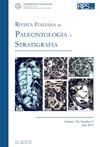THE QUIBAS SITE (MURCIA, SPAIN): NEW HERBIVORES FROM THE EARLY-MIDDLE PLEISTOCENE TRANSITION
IF 1.9
3区 地球科学
Q2 GEOLOGY
引用次数: 0
Abstract
The Lower Pleistocene site of Quibas, in Sierra de Quibas (Murcia, Spain) was discovered in 1994 and has since then provided abundant material of typical Epivillafranchian taxa. This biochron belongs to the Early-Middle Pleistocene transition (1.2 – 0.78 Ma), characterised by a change in orbital cyclicity from a 41 kyr cycle to 100 kyr that intensified the climate and culminated in the most important faunal turnover of the Pleistocene regarding large mammals. The Group of Palaeoanthropology of the National Museum of Natural Sciences (CSIC, Spain) and the Institut Català de Paleoecologia Humana i Evolució Social (IPHES-CERCA, Spain) carried out four field seasons from 2015 to 2018. Here we present the large herbivorous mammals recovered from the field, including the first citation of two taxa new to the locality: Stephanorhinus cf. etruscus and Bison cf. voigtstedtensis. We also provide the first description of previously mentioned taxa: Dama cf. vallonnetensis and Sus sp. Together with the remaining herbivores, the faunal community shows a strong European affinity with some regionalism. Compared with other Iberian localities, the site of Quibas stands out for the lack of hominin fossils or any evidence supporting their presence in the area, a peculiar scenario given that the Early-Middle Pleistocene transition broadly speaking sees the arrival of humans into Europe.quibas遗址(西班牙穆尔西亚):早-中更新世过渡时期的新食草动物
位于Sierra de Quibas(西班牙穆尔西亚)的下更新世Quibas遗址于1994年被发现,自那时以来,该遗址为典型的Epivillafranchian类群提供了丰富的材料。这种生物炭属于中更新世早期的过渡期(1.2–0.78 Ma),其特征是轨道周期从41 kyr周期变化到100 kyr,这加剧了气候,并最终导致更新世最重要的大型哺乳动物动物群更替。2015年至2018年,国家自然科学博物馆(CSIC,西班牙)的古人类学小组和人类进化社会加泰罗尼亚研究所(IPHES-CERCA,西班牙)进行了四次实地考察。在这里,我们介绍了从野外发现的大型草食性哺乳动物,包括首次引用当地新的两个分类群:Stephanorhinus cf.etruscus和Bison cf.voigtstedtensis。我们还提供了前面提到的分类群的第一个描述:Dama cf.vallonnetensis和Sus sp.与剩下的食草动物一起,动物群落显示出强烈的欧洲亲和力和一些区域主义。与其他伊比利亚地区相比,奎巴斯遗址因缺乏原始人化石或任何支持其在该地区存在的证据而引人注目,这是一种特殊的情况,因为从广义上讲,早更新世中期的过渡见证了人类进入欧洲。
本文章由计算机程序翻译,如有差异,请以英文原文为准。
求助全文
约1分钟内获得全文
求助全文
来源期刊
CiteScore
3.60
自引率
4.30%
发文量
28
审稿时长
>12 weeks
期刊介绍:
The Rivista Italiana di Paleontologia e Stratigrafia was founded in 1895. It publishes original papers dealing with all fields of paleontology and of stratigraphy, from Italy and the Mediterranean to the Tethys, as well across the globe from China to North America.

 求助内容:
求助内容: 应助结果提醒方式:
应助结果提醒方式:


